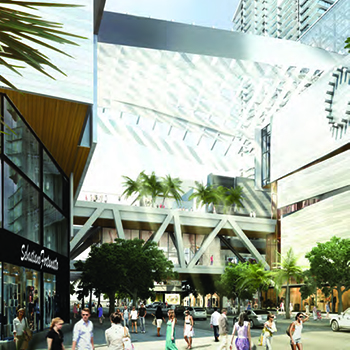Height rank
Conrad Seoul
Seoul
-
Metrics
You must be a CTBUH Member to view this resource.
Official Name
Conrad Seoul
Other Names
International Finance Center Hotel, Conrad Seoul at International Finance Center
Name of Complex
Type
Building
Status
Completed, 2012
Country
City
Address
Function
A mixed-use tall building contains two or more functions (or uses), where each of the functions occupy a significant proportion of the tower's total space. Support areas such as car parks and mechanical plant space do not constitute mixed-use functions. Functions are denoted on CTBUH "Tallest Building" lists in descending order, e.g., "hotel/office" indicates hotel function above office function.
hotel
Structural Material
Both the main vertical/lateral structural elements and the floor spanning systems are constructed from steel. Note that a building of steel construction with a floor system of concrete planks or concrete slab on top of steel beams is still considered a “steel” structure as the concrete elements are not acting as the primary structure.
Reinforced Concrete
Both the main vertical/lateral structural elements and the floor spanning systems are constructed from concrete which has been cast in place and utilizes steel reinforcement bars.
Precast Concrete
Both the main vertical/lateral structural elements and the floor spanning system are constructed from steel reinforced concrete which has been precast as individual components and assembled together on-site.
Mixed-Structure
Utilizes distinct systems (e.g. steel, concrete, timber), one on top of the other. For example, a steel/concrete indicates a steel structural system located on top of a concrete structural system, with the opposite true of concrete/steel.
Composite
A combination of materials (e.g. steel, concrete, timber) are used together in the main structural elements. Examples include buildings which utilize: steel columns with a floor system of reinforced concrete beams; a steel frame system with a concrete core; concrete-encased steel columns; concrete-filled steel tubes; etc. Where known, the CTBUH database breaks out the materials used in a composite building’s core, columns, and floor spanning separately.
composite
Official Website
Height
199.4 m / 654 ft
Floors Above Ground
38
# of Hotel Rooms
466
-
By function
You must be a CTBUH Member to view this resource.
-
By material
You must be a CTBUH Member to view this resource.
Construction Start
Completed
Structural Engineer
The Design Engineer is usually involved in the front end design, typically taking the leadership role in the Schematic Design and Design Development, and then a monitoring role through the CD and CA phases.
You must be a CTBUH Member to view this resource.
Owner
American International Group; The Seoul Metropolitan Government
Architect
Usually involved in the front end design, with a "typical" condition being that of a leadership role through either Schematic Design or Design Development, and then a monitoring role through the CD and CA phases.
Arquitectonica
Structural Engineer
The Design Engineer is usually involved in the front end design, typically taking the leadership role in the Schematic Design and Design Development, and then a monitoring role through the CD and CA phases.
Other Consultant
Other Consultant refers to other organizations which provided significant consultation services for a building project (e.g. wind consultants, environmental consultants, fire and life safety consultants, etc).
Other Consultant refers to other organizations which provided significant consultation services for a building project (e.g. wind consultants, environmental consultants, fire and life safety consultants, etc).
Vidaris, Inc.
Vidaris, Inc.
Videos

17 October 2016 | Seoul
The Roots of Tall Buildings: Connecting the City
This presentation investigated the integration of tall tower, mixed-use developments and how they connect with the city and the public when they meet the ground....
Research

17 October 2016
The Roots of Tall Buildings: Connecting the City
Peter Brannan, Arquitectonica
This paper investigates the integration of tall tower, mixed-use developments and how they connect with the city and the public when they meet the ground....
About Conrad Seoul
The International Finance Centre, located at the center of Yeouido Island, serves as a major pedestrian link between the subway station, riverside, and Yeouido Plaza Park. The inspiration for the IFC Seoul came from Asian landscape drawings that often depict very steep, jagged mountains. The four vertical towers were designed to resemble monumental crystalline outcroppings, chiseled to create prismatic forms that accentuate the interplay of light and shadow on the glass façade.
Expansive floor-to-ceiling glass and nearly 10-foot ceilings immerse the office spaces in natural light and provide magnificent, uninterrupted views across Yeouido Park and the Han River to the mountains beyond. Bay depths of more than 42 feet (12.8 meters) from elevator core to the perimeter wall ensure efficient use of space. To improve the experience on subterranean levels, the design includes large skylights to admit natural light, articulating the glass entry pavilions leading into the IFC Seoul Mall.
Subscribe below to receive periodic updates from CTBUH on the latest Tall Building and Urban news and CTBUH initiatives, including our monthly newsletter. Fields with a red asterisk (*) next to them are required.
View our privacy policy










